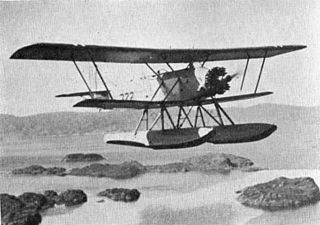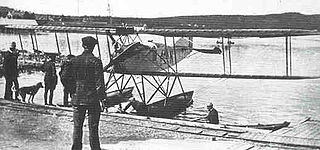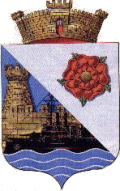
The Heinkel He 115 was a three-seat World War II Luftwaffe seaplane. It was used as a torpedo bomber and performed general seaplane duties, such as reconnaissance and minelaying. The aircraft was powered by two 960 PS BMW 132K nine-cylinder air-cooled radial engines. Some later models could seat four, had different engines or used different weapon arrangements.

HNoMS Uller was a Vale-class Rendel gunboat constructed for the Royal Norwegian Navy at Karljohansverns Verft Naval Yard in Horten in 1874-1876 and had yard build number 55. She was one of a class of five gunboats - the other ships in the class were Vale, Brage, Nor and Vidar.

Oskar Omdal was a lieutenant and pilot in the Royal Norwegian Navy.

HNoMS Kjell was the final ship of twenty-seven 2nd class torpedo boats built for the Royal Norwegian Navy, launched at the Royal Norwegian Navy's shipyard in Horten on 12 March 1912 with build number 106. Kjell saw more than 32 years of service, the first 28 years in the Royal Norwegian Navy during the First World War and in the interwar period, the last four in the Kriegsmarine, having been captured in the first days of the 1940 Norwegian Campaign. After being rebuilt as a minesweeper by the Germans, she was sunk by Royal Air Force de Havilland Mosquito fighter bombers on 28 September 1944. Divers rediscovered the shipwreck in 2006.

The Marinens Flyvebaatfabrikk M.F.11 was a three-seat, single-engined biplane used by the Royal Norwegian Navy Air Service for maritime reconnaissance in the decade before the Second World War.

HNoMS Gyller was a Sleipner-class destroyer commissioned into the Royal Norwegian Navy in 1938. Along with the other Sleipner-class vessels in commission at that time, she took part in protecting Norwegian neutrality during the Second World War. After initially serving in the far north during the Finno-Soviet Winter War, she was redeployed to Southern Norway, escorting ships through Norwegian territorial waters. When the Germans invaded Norway on 9 April 1940, she was docked at Kristiansand. After taking part in the defence of the port city, she was captured intact by the invading Germans. Renamed Löwe, she sailed with Nazi Germany's Kriegsmarine for the duration of the war.

The Marinens Flyvebaatfabrikk M.F.12 was a seaplane built in Norway in 1939 as a military trainer aircraft to replace the Norwegian Navy's aging fleet of M.F.8 trainers. Only a single prototype was constructed before Germany's invasion of Norway in 1940. The prototype, M.F.12 F.14 (V), was the last trainer built for the Royal Norwegian Navy Air Service (RNNAS).

The Marinens Flyvebaatfabrikk MF.8 was a military training seaplane built in Norway in the 1920s.

The Marinens Flyvebaatfabrikk M.F.9 Høverjager, also known as the Høver M.F.9 after its designer, was a fighter seaplane built in Norway in the 1920s.The Illustrated Encyclopedia of Aircraft. London: Aerospace Publishing. p. 2144.

The Marinens Flyvebaatfabrikk M.F.10 was a military trainer seaplane built in Norway in 1929.

The Marinens Flyvebaatfabrikk M.F.1 was a two-seat biplane floatplane, the first aircraft produced by the Royal Norwegian Navy Air Service's aircraft factory Marinens Flyvebaatfabrikk in Horten, built after Maurice Farman's MF.7 design. The construction began in the summer of 1915, with plans borrowed from the Norwegian Army Air Service's aircraft factory at Kjeller.
The Marinens Flyvebaatfabrikk M.F.3 was a reconnaissance floatplane built by the Royal Norwegian Navy Air Service aircraft factory Marinens Flyvebaatfabrikk in 1917. The aircraft was financed by extraordinary appropriations during the First World War and served until October 1924.
Kristian August Østby was a Norwegian naval aviator.
The Marinens Flyvebaatfabrikk M.F.4 was a biplane floatplane built by the Royal Norwegian Navy Air Service aircraft factory Marinens Flyvebaatfabrikk from 1918. The aircraft was the first purpose-built trainer aircraft in Norwegian service and served until retired in October 1924.
The Marinens Flyvebaatfabrikk M.F.5 was a two-seat biplane floatplane built by the Royal Norwegian Navy Air Service aircraft factory Marinens Flyvebaatfabrikk from 1918. The M.F.5 was the first tractor configuration aircraft designed and built in Norway. During almost eight years of service the M.F.5 was mainly used as a reconnaissance aircraft, although one example saw service as a trainer.
The Marinens Flyvebaatfabrikk M.F.7 was a two-seat biplane floatplane built by the Royal Norwegian Navy Air Service aircraft factory Marinens Flyvebaatfabrikk in 1923. The M.F.7 was designed and employed as a trainer aircraft, and functioned as a temporary solution until a better aircraft was designed. Soon after it entered service, the aircraft factory's experience with the M.F.7 led to the construction of the Marinens Flyvebaatfabrikk M.F.8, which remained in service as the main trainer aircraft of the Royal Norwegian Navy Air Service until the German invasion of Norway in 1940.
The Marinens Flyvebaatfabrikk M.F.6 was a two-seat biplane floatplane built by the Royal Norwegian Navy Air Service aircraft factory Marinens Flyvebaatfabrikk in 1921. The M.F.6 was designed and employed as a trainer aircraft. The type was the last pusher configuration aircraft in service with the Royal Norwegian Navy Air Service. The M.F.6 functioned as a makeshift solution until a more modern tractor configuration aircraft could be built. The type was retired once a more permanent solution to the Royal Norwegian Navy Air Service's training needs was found in mid-1920s.

Kristiansand Naval Air Station was a water military air base operated by the Royal Norwegian Navy Air Service between 1919 and 1940. Situated at Tangen in the city center of Kristiansand, Norway, it consisted of three hangars. The station was to house both reconnaissance and fighter aircraft.

Kristiansand Airport, Kongsgårdbukta was a water airport serving Kristiansand, Norway, from 1934 to 1939. Situated at Kongsgårdbukta, it consisted of a floating dock and a small terminal building. Widerøe served the airport the first year, thereafter flights were carried out by Norwegian Air Lines. The airport was closed for the opening of Kristiansand Airport, Kjevik.





















